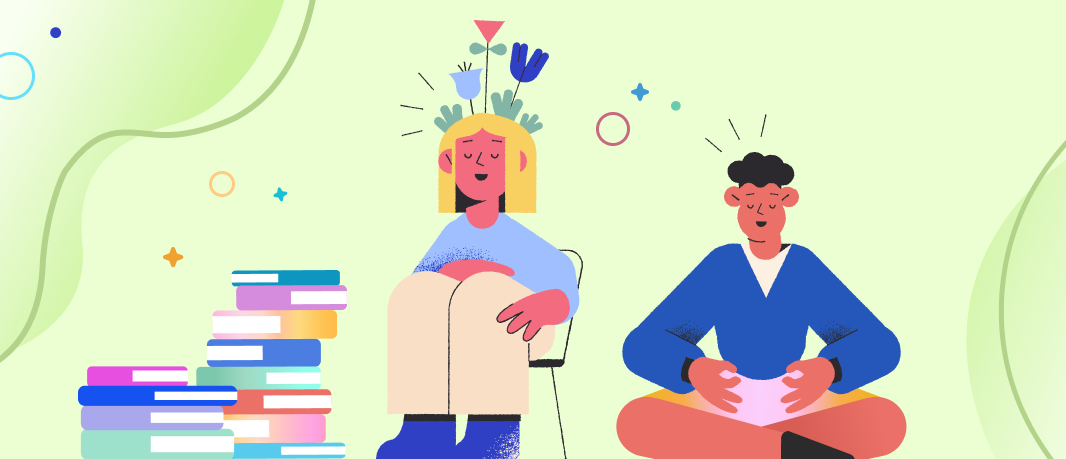Do you want to give your students the tools to regulate their own emotions and reduce their stress levels? Some of the most valuable resources teachers have to help with this are mindfulness practices. When teachers educate mindfully and share mindfulness activities students can use, the classroom will become a more open, inviting, and productive space.
What is Mindfulness?
According to Harvard University, mindfulness is alert, open awareness of what is happening in the current moment, both in your environment and in your body. Mindfulness can apply to all aspects of life, including in the classroom. In education, it can help students manage their stress in difficult situations and stay engaged in the material that’s being presented. Not only does mindfulness minimize the stress students experience, it also helps support mental, emotional, and physical health.
Mindfulness is a newly popular term, but it is not a new concept. Many religious and philosophical groups have used this concept over the centuries. However, it became popular in recent years when Buddhist and Hindu teachings made their way to Western culture. That said, mindfulness is not a religious concept. It is a state of awareness that benefits people from all walks of life.
What is Mindfulness in Education?
To incorporate mindfulness into education, teachers will bring in activities that engage students in mindfulness techniques. These techniques teach students how to become more self-aware, take care of their own bodies, and manage their emotions. When students apply this well, mindfulness is not an added activity but rather gets woven into the curriculum, so they learn to accept and embrace it daily.
If you are an educator looking to add mindfulness activities to the classroom, there are some specific ways you can do so. Below are some fun mindfulness practices that can assist you in creating a classroom where students are aware of themselves, their emotions, and their environment.
Top Mindfulness Activities for Students
The best way to encourage mindfulness in your students is two-fold. First, teachers can model mindfulness themselves. Second, cultivate weaving mindfulness activities into the day, so students learn to apply these practices in different situations.
A great way to start including mindfulness in the curriculum is to create a comprehensive mindfulness challenge for your students. This challenge can include several different mindfulness activities and outline certain goals for students to achieve. Here are some fun mindfulness exercises and activities to consider incorporating:
Mindful Reading
Mindful reading involves short breaks of time when students sit and read. During mindful reading times, students should be allowed to read what they enjoy. Studies have shown that reading for as little as six minutes reduces stress by as much as 68%. After a set period of time, usually around 10 minutes, encourage your students to have conversations about their reading material and the emotions that came with it. Make sure you share your own observations to help get the discussions going.
In addition to reducing stress, mindfulness reading exercises in your classroom may help change your students’ perspectives by encouraging them to look at life from another point of view. This, in turn, will help them become aware of the emotions and feelings of others, which can improve their own emotional regulation.
Mindfulness Meditation
Meditation is a great way to encourage mindfulness in your students, but it does take some practice. Guided mindfulness meditation can help your students learn to calm their bodies and connect to their emotional state. You can find guided meditation videos on YouTube in a variety of lengths which the class can follow along with, or you can learn the techniques and lead the meditation practice yourself.
One way to get started with meditation is to have your students sit on the floor with their legs uncrossed and feet flat on the floor. Ask them to place their hands on their thighs, palms up. After they close their eyes, have them exhale completely. Give them a word to focus on, and repeat that word several times. Encourage the students to focus on that word and move other thoughts from their minds as they breathe deeply. Let them sit in this calm way for a few minutes, then slowly have them open their eyes to return to schoolwork.
Yoga, Mindful Breathing, and Other Mindful Movement
Yoga and mindful movement activities engage the mind and emotions as well as the body. Yoga stretches can help kids learn to move their bodies while encouraging mindfulness. If possible, take them outdoors to walk in nature slowly, moving their body while taking in their natural environment.
Another option to consider is mindful breathing. An activity called color breathing can work well in the classroom. Ask your students to think of two colors, one that is relaxing and one that represents anger or frustration. With their eyes closed, have them imagine exhaling out the negative color for a slow count of five. Follow that with an inhale of the relaxing color for a slow count of five.
Pinwheel breathing is another activity that works well for young children. While holding a pinwheel, students practice deep breaths by spinning the pinwheel while breathing out. This will show them how to breathe deeply, which is a great way to teach them to calm their own emotions with breathing.
Practicing Gratitude Daily
What are you thankful for? Asking your students this question can move them away from negative thinking and on the path to positive thoughts, and is a great way to spark mindfulness. Have your students write one thing they are grateful for into a journal at the start of the day as an easy and impactful way to incorporate this daily. You can complete this practice as a paired sharing activity or by offering them simple prompts to consider.
Mindful Affirmations
Mindful affirmations are positive words or phrases that are repeated out loud or to oneself. These affirmations serve as an anchor that students can come back to when they are distracted, feeling down, or stressed. When students handle these situations in a healthy way, they open the door to succeed academically, socially, and emotionally. Have your students repeat positive affirmations to themselves daily. Teach them to use positive affirmations with their peers. When students state these out loud, it gives them power and will help them start to internalize positive thinking.
Mindful Journaling and Coloring
Mindful journaling is similar to writing diary entries, but instead of focusing on the activities and experiences, these journals focus on processing a person’s thoughts and feelings in a moment. Consider having students journal about how something makes them feel to incorporate this technique into the day and improve emotional regulation.
Mindful coloring is a similar idea, but rather than using words, the student uses colors. This is a great option for students who may not be able to or be comfortable with journaling their feelings. Give them paper or a coloring page, and encourage them to use colors that match their feelings.
Benefits of Mindfulness for Students
When you bring mindfulness into your classroom, it carries several benefits, including:
Relieving Stress and Anxiety
It’s a stressful world out there, especially for children. When you use techniques to calm the mind and body, they can help reduce the negative effects of stress, including behavioral problems in the classroom. The American Psychological Association indicates mindfulness lowers the stress response by reducing blood pressure and heart rate, so students feel less stress. With less stress, your students will have a greater well-being and be better equipped to handle stressful situations. The positive psychological benefits will help support many aspects of students’ day-to-day lives, including anxiety related to school like test-taking.
Improving Self-Regulation
Self-regulation can be categorized into two categories: behavioral and emotional. Behavioral self-regulation includes behaving in concurrence with your personal values and goals. Emotional self-regulation is the ability to react to an experience with a range of emotions in a flexible way, delay spontaneous reactions, and handle disruptive impulses and emotions appropriately. Overall, self-regulation is the “control of oneself, by oneself.” Both forms of self-regulation are impacted positively with mindful practices.
Students who practice mindfulness are better able to regulate and gain control over their emotions. Mindfulness also encourages positive moods. When students can maintain control of their positive and negative emotions, they can better communicate their needs, helping to improve the classroom environment.
Improved self-regulation also enhances a student’s own mindful awareness of their emotions. This is the foundation of strong emotional intelligence. When students have emotional intelligence, they have more empathy and compassion for both themselves and their peers. Additionally, improved emotional skills mean students have more kindness as well, which helps promote supportive relationships.
Improved emotional intelligence and emotional regulation help students build their interpersonal communication skills. When students can communicate better with their peers and develop empathy for those peers, they respond better socially and are able to learn in a more engaging way.
Self-regulation and increased emotional intelligence also give students more self-compassion. They understand their emotions and their emotional triggers. This allows them to treat themselves with kindness. When they have self-compassion, it also reflects in the way they interact with and treat others.
Enhancing Academic Performance
When students have less stress and better emotional intelligence, they are able to perform better academically. The National Institutes of Health found that college students with lower perceived stress and increased mindfulness had better cognitive function than those who did not. The University of California found that greater mindfulness and better academic performance in school were closely connected.
Mindfulness lengthens attention spans and helps students stay engaged. Additionally, it helps build a student’s ability to focus. Over time, mindfulness can sharpen memory and improve mental performance, improving academic achievement overall.
How Beanstack Helps Promote Mindfulness
Reading is just one of the ways you can promote mindfulness in your classroom. In fact, one of the many proven benefits of reading is stress reduction. Beanstack is a tool that can help develop mindfulness in your school or classroom, especially if you want to incorporate mindful reading into your curriculum. Additionally, you can create a mindfulness reading challenge in Beanstack to easily share reading lists and create activity badges students can earn for completing mindful activities like the ones highlighted above.
To discover how Beanstack can help you embrace and promote mindfulness in your school district, contact our team to request a quote and learn more.


